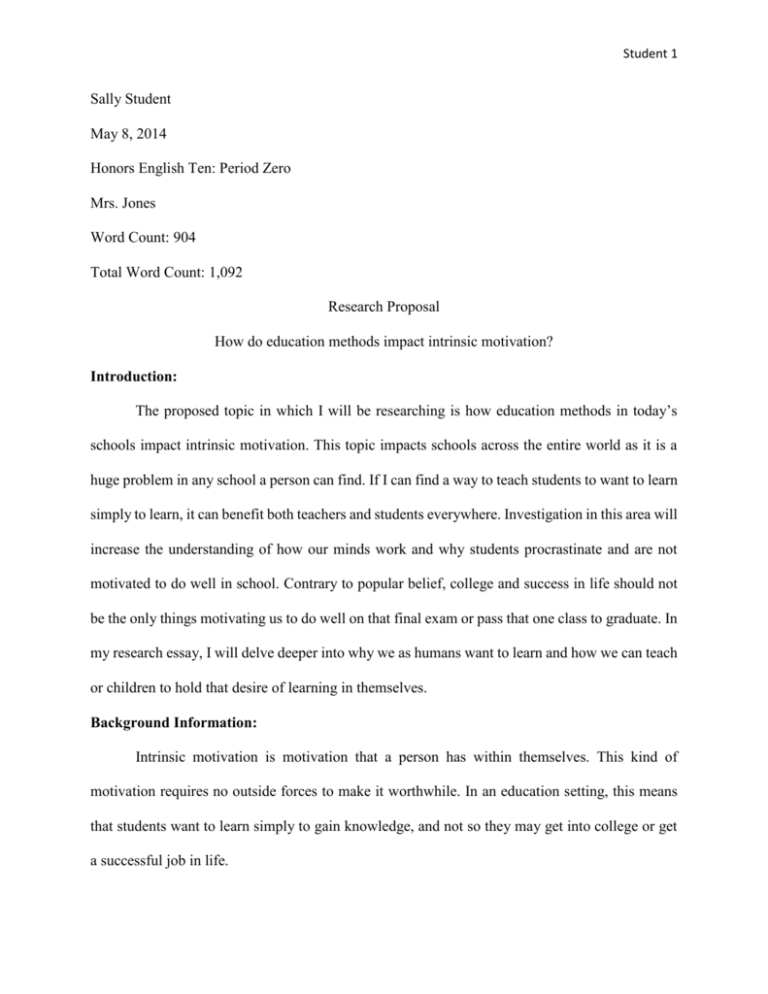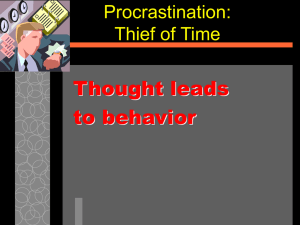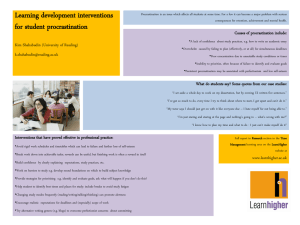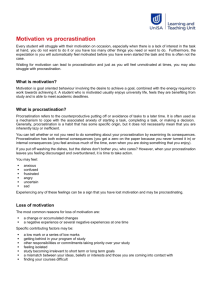Student Sally Student May 8, 2014 Honors English Ten: Period Zero
advertisement

Student 1 Sally Student May 8, 2014 Honors English Ten: Period Zero Mrs. Jones Word Count: 904 Total Word Count: 1,092 Research Proposal How do education methods impact intrinsic motivation? Introduction: The proposed topic in which I will be researching is how education methods in today’s schools impact intrinsic motivation. This topic impacts schools across the entire world as it is a huge problem in any school a person can find. If I can find a way to teach students to want to learn simply to learn, it can benefit both teachers and students everywhere. Investigation in this area will increase the understanding of how our minds work and why students procrastinate and are not motivated to do well in school. Contrary to popular belief, college and success in life should not be the only things motivating us to do well on that final exam or pass that one class to graduate. In my research essay, I will delve deeper into why we as humans want to learn and how we can teach or children to hold that desire of learning in themselves. Background Information: Intrinsic motivation is motivation that a person has within themselves. This kind of motivation requires no outside forces to make it worthwhile. In an education setting, this means that students want to learn simply to gain knowledge, and not so they may get into college or get a successful job in life. Student 2 As stated in An Overview of Student Teachers’ Academic Intrinsic Motivation by Melis Uyulgan and Nalan Akkuzu, “even if individuals have a great quality of learning skills, they will not be able to reach long-term targets without motivation” (1). No matter how great a student may be in schooling, they can never get to where they want to go without their own motivation within themselves. In this same essay, it is stated that “factors such as gender, academic success, studying environment, and peer relations, as well as the requirements and expectations of authorities such as teachers and parents, affect the academic motivation of students” (2). It is known that these factors play into motivation, yet do other factors play in as well? In A Longitudinal Study of School Belonging and Academic Motivation Across High School by Cari Gillen-O’Neel and Andrew Fuligni, it is stated that “high school students’ school belonging translates into higher academic achievement and motivation” (1). Making students feel like they belong in their school throughout their peers can impact how they are motivated to do things. If we can make each student feel accepted in the school system, they will be less likely to drop out of the greatest gift of education life has to offer. In another article, Motivating Learning in Young Children, by NASP Resources, different techniques to nurture motivation in very young children are analyzed. “For parents of young children, the goal should be to appropriately support the development of motivation so that there is a proper foundation for optimal education growth” (2). It shows the steps to properly motivate young children, even toddlers, to have a desire to learn. Along with teaching methods, procrastination can also affect motivation. In A Comparison of Active and Passive Procrastination in Relation to Academic Motivation by Eun Hee Seo, active and passive procrastination are shown to affect motivation. “Active procrastinators make intentional decisions to procrastinate, thus applying strong motivation under time pressure, they Student 3 are able to complete tasks before deadlines, and achieve satisfactory outcomes. In contrast, passive procrastinators are traditional procrastinators who postpone their tasks until the last minute with feelings of guilt and depression and are more likely to fail to complete tasks” (778). These two types of procrastination can greatly impact a student’s motivation and can change a student’s outlook on school. Above all, the most surprising thing that can impact motivation is the size of schools. As stated in Differences in Students’ Motivation to Attend College: Large Versus Small High Schools, by Brittney Horyna and Jennifer M. Bonds-Raacke, “smaller schools are often found to be associated with several, beneficial results for their students. These may include higher levels of attendance coupled with lower dropout rates” (709). The size of a school a student attends could greatly impact their motivation to stay due to the high amount of people around them and low amount of teachers. Reversed, however, could make a student hold a greater desire to learn. Personally, I have had experience in this topic throughout my moving from California to Arizona. In California, I was in elementary school, and I was never worried about how I did in school affecting the rest of my life. No one told me that if I got bad grades it would haunt me the rest of my life, so I never worried. When I moved to Arizona, however, I began junior high and high school. The main focus of nearly all my teachers was to get me ready for high school and then college so I could later have a successful career. Quickly I began to think that everything I did weighed heavily on my future life, and that I wouldn’t do well in life if I messed up in school. Soon the stresses came, and my only motivation to learn in school was so I could pass the tests, not so I could truly learn the information. Along with stresses of life, my belonging in school influenced my motivation. In California, in elementary school, I was surrounded with plenty of friends to keep me company, Student 4 and I knew school was a happy place for me to go. In thinking so, I was inspired to learn everything I could in school and I still can remember some of those simple fourth grade lessons. Statement of Problem/Area of Inquiry: I should study this topic because of my deep passion for school and learning. It has always interested me how I love to learn whereas others around me despise it. Is it because they feel forced to learn in order to succeed in my life whereas I grew up wanting to learn because I thought it was fun? It is my determination to find the answer to this question. Through researching this topic, teachers will gain a better understanding of how to teach their students to nurture a desire of leaning in their hearts. It will also teach students how to place that very desire within them that learning for the sake of learning is a beautiful thing. Some new questions I could pose to this field include how friendships in school affect motivation and how bullying can destroy a person’s desire to go to school. Throughout this research paper, I hope to discover exactly how education methods impact intrinsic motivation in students today. Student 5 Annotated Bibliography EUN HEE, SEO. "A Comparison of Active and Passive Procrastination In Relation To Academic Motivation." Social Behavior & Personality: An International Journal 41.5 (2013): 777786. Academic Search Premier. Web. 8 May 2014. In this article, active and passive procrastination are being analyzed. Active procrastination is the deliberate decision by a student to push of work, which then in contrast motivates them to get things done quickly. Passive procrastination, on the other hand, is the subconscious decision by a student to procrastinate that often leads them to feel guilt and to do the work poorly. These students lack the motivation to do this quickly and effectively. This article delves into how procrastination, in many ways, can both motivate you and make you less motivated to do anything. This is a very useful source in identifying how students motivate or demotivate themselves through their work ethics. It can show the effects of procrastination and how it can teach a student to be quick and efficient or slow and precise. It is a reliable source from Seoul Women’s University that can be relied on. This article is also reliable because it has no bias. It simply gives information that is credible. It has helped me think of different branches of my topic other than just looking at motivation alone. Horyna, Brittney, and Jennifer M. Bonds-Raacke. "Differences In Students' Motivation To Attend College: Large Versus Small High Schools." Education 132.4 (2012): 708-724. Academic Search Premier. Web. 8 May 2014. Student 6 In this article, the size of a school is evaluated and the impact on students based on the size of their school is recorded. According to the article, small schools tend to have more students motivated to attend. This may lead to more of a want to learn in students and a much lower dropout rate in schools. This article also discusses the effects of intrinsic motivation, extrinsic motivation, and no motivation on whether a student stays in school through college. This source is useful as it neatly describes the effects of all kinds of motivation on a student in high school. It also puts an interesting perspective on how school size could impact a student’s intrinsic motivation. This is a reliable source from Fort Hays State University that I can rely on to give me facts and data. Although it is biased, the information presented is fact. The opinions on that information, however, could help me in presenting how school size and different types of motivation affect our students. "Motivating Learning in Young Children." NASP Resources. N.p., n.d. Web. 08 May 2014. <http://www.nasponline.org/resources/home_school/earlychildmotiv_ho.aspx>. This article goes deeply into the art of intrinsic motivation. It describes when, in the early stages of childhood, a person first starts to lose their own sense of motivation and how others can enhance that motivation or grow it so that it is not lost forever. This article also gives many different suggestions for teachers, parents, and friends to plant the want to learn inside a young person’s mind. Student 7 This article gives many useful answers to the question asked of how to motivate children. It is fairly reliable due to its tests and research. The article is biased to the side that intrinsic motivation is necessary in any person, but it gives many incredible insights to motivation of young children and older ones. It has helped me look at the benefits of intrinsic motivation not only in high school but also in elementary school. Neel, Cari Gillen-O', and Andrew Fuligni. "A Longitudinal Study of School Belonging and Academic Motivation Across High School." Child Development 84.2 (2013): 678-692. Academic Search Premier. Web. 8 May 2014. This article gives a deep evaluation of how a student’s sense of belonging in high school can affect dropout rates and the amounts of students willing to move on to a higher education. A student who does not feel they fit in at school will slowly despise even going, leading to dropping out or only finishing through a high school degree. Not only that, but this article also describes how the location of a school can affect a student’s motivation. This article is very helpful as it shows the analysis of factors within a school that affect motivation and not just how a teacher gives lessons in a classroom setting. This article is very reliable as it shows research conducted by the University of California and it contains no bias. The information is clearly presented and has no push to a good or bad side of things; though the data clearly shows high school belonging is necessary in motivation. Student 8 UYULGAN, Melis Arzu, and Nalan AKKUZU. "An Overview of Student Teachers' Academic Intrinsic Motivation." Educational Sciences: Theory & Practice 14.1 (2014): 24-32. Academic Search Premier. Web. 8 May 2014. This article describes what truly goes through a student’s mind as they decide what kind of future education they want. It dives into why student’s dropout and how their decision can affect them. In most public school environments today, students only learn to get the grade because all they care about is their future after high school. What students do not care about, however, is the knowledge they are gaining. This article clearly describes why and how students can place intrinsic motivation within themselves. This article is helpful in the sense that it gives a better understanding of why students feel that learning is not fun and why they do not learn simply for the sake of learning. It is a strong and reliable source from Dokuz Eylul University that contains some bias but in a good light. It encourages teachers to show students the true magic behind learning. It has helped me see the true process of motivation inside a person’s mind and helped me look at the big picture of my research paper topic.







